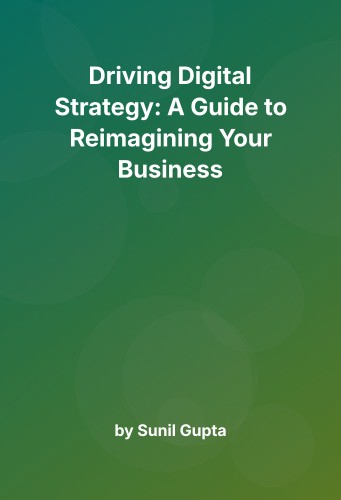Summary
In Driving Digital Strategy, Harvard Business School professor Sunil Gupta delivers a clear, research-backed guide for executives navigating the complex terrain of digital transformation. Unlike narrow views that equate digital strategy with marketing or IT upgrades, Gupta emphasizes a holistic rethinking of the business—its models, operations, culture, and value creation logic.
Gupta argues that traditional businesses fail not because they ignore technology, but because they fail to integrate digital thinking into their core strategic vision. His book is structured around four domains where digital technology enables transformation: business models, customer engagement, value chains, and organizational structures.
Rethinking Business Models
Gupta urges leaders to abandon the outdated notion that digital transformation is about simply “adding” digital capabilities. True transformation often requires changing the fundamental business model.
Platform Thinking
The shift from pipeline to platform models is a major theme. Examples include:
- Apple’s App Store (ecosystem-based value)
- Uber and Airbnb (multi-sided markets)
- Amazon (hybrid platform-retailer)
Platform businesses grow faster and scale more easily by enabling third parties to create value. Gupta recommends exploring where companies can move from owning assets to orchestrating interactions.
Revenue Model Innovation
Gupta encourages firms to explore subscription models, freemium pricing, pay-as-you-go, and bundling as alternatives to traditional transactional approaches. Examples include:
- Adobe’s shift to SaaS
- Michelin’s “tires-as-a-service”
These models create recurring revenue and deeper customer relationships.
Rethinking Customer Engagement
Digital technologies change how companies interact with and understand customers.
Journey Mapping
Traditional funnel thinking is outdated. Instead, businesses should map customer journeys and identify “moments of truth” that matter most. Tools like Google’s ZMOT and A/B testing are vital.
Personalization at Scale
With the help of AI and big data, firms can now offer individualized experiences. Gupta highlights:
- Netflix’s content recommendations
- Amazon’s purchase suggestions
Personalization increases relevance, conversion, and loyalty.
Omnichannel Strategy
The rise of digital channels does not eliminate physical stores; rather, it elevates the need for seamless integration. Gupta shows how retailers like Sephora and Nordstrom use digital tools in-store to enhance service.
Rethinking the Value Chain
Digital technologies allow organizations to redesign internal operations.
Disintermediation and Reintermediation
Gupta explores how companies can bypass traditional intermediaries (e.g., Warby Parker bypassing opticians) or create new ones (e.g., Google becoming the gateway for information).
Supply Chain Transformation
With IoT, predictive analytics, and cloud integration, supply chains become real-time, responsive, and transparent. Examples:
- Zara’s fast fashion based on live data
- GE’s digital twins for asset management
Digitizing the Product Itself
Products can become smart, connected, and service-enabled. Gupta references:
- John Deere’s data-driven agriculture
- Tesla’s over-the-air software updates
These shifts blur the line between product and service and require new capabilities.
Rethinking Organizational Structure
Transformation demands more than process and technology—it requires new ways of working and leading.
Silos and Alignment
Gupta criticizes siloed organizations where digital is “owned” by IT or marketing. He advocates for cross-functional teams, shared KPIs, and customer-focused alignment.
Leadership Commitment
Senior leaders must model the change they want to see. Digital transformation is not a project—it’s a strategic capability. CEOs must act as digital champions.
Talent and Culture
Companies must:
- Upskill existing talent
- Attract new digital natives
- Create cultures of experimentation and agility
Gupta cites Unilever’s reverse mentoring and McKinsey’s digital academies as best practices.
Implementing Digital Strategy
Don’t Copy Silicon Valley
While it’s tempting to emulate tech companies, Gupta warns against blindly applying startup playbooks. Instead, companies should identify their own sources of advantage and build from there.
Test-and-Learn Mentality
Embrace experimentation with:
- MVPs (Minimum Viable Products)
- A/B testing
- Fast feedback loops
Failure should be seen as a learning opportunity—not a career-killer.
Invest in Platforms and Ecosystems
Gupta encourages building or joining ecosystems that reinforce customer engagement and innovation. For example, Nike’s digital ecosystem connects shoes, sensors, mobile apps, and community.
Case Studies
- The New York Times successfully transitioned to a digital subscription model, investing in journalism and UX instead of ad-driven clickbait.
- Best Buy reinvented its physical stores as experience centers, countering Amazon with price matching and better service.
- Hilti moved from selling power tools to offering “tools-as-a-service,” improving uptime and customer retention.
Each example illustrates a broader transformation in strategy and culture, not just technology adoption.
Measuring Success
Digital transformation requires new metrics beyond traditional KPIs. Gupta suggests:
- Customer lifetime value (CLV)
- Net promoter score (NPS)
- Engagement and retention rates
- Speed to market
- Digital share of revenue
These help organizations stay focused on outcomes, not just outputs.
Overcoming Barriers
Gupta identifies common pitfalls:
- Legacy systems and mindsets
- Short-term financial pressures
- Misaligned incentives
- Fear of cannibalization
His remedy is long-term commitment, cross-functional collaboration, and clear alignment to customer value.
Strategic Framework
Gupta proposes a framework built on four questions:
- How can we reimagine our business model for the digital age?
- How do we enhance customer journeys through digital?
- How do we use digital to transform our value chain?
- What organizational changes must support this transformation?
This model offers a practical roadmap for business leaders.
Why This Book Matters
Driving Digital Strategy provides a strategic lens for digital transformation. It avoids techno-optimism and focuses on real business change. Gupta’s work is grounded in both academic research and hands-on consulting, making it both rigorous and practical.
Leaders across sectors—from retail and manufacturing to healthcare and finance—will find this book a valuable guide to future-proofing their business.
TL;DR
Digital transformation is not about tools—it’s about strategy. Sunil Gupta shows how to rethink your business model, engage customers in new ways, rewire operations, and lead cultural change. Driving Digital Strategy is the blueprint for building digital advantage.

